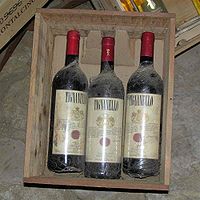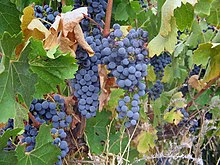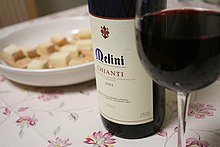Tuscan wine

Tuscan wine is
History


The history of viticulture in
The Arte dei Vinattieri guild established strict regulations on how the Florentine wine merchants could conduct business. No wine was to be sold within 100 yards (91 m) of a church. Wine merchants were also prohibited from serving children under 15 or to
Following the end of the
Climate and geography

The
The Sangiovese grape performs better when it can receive more direct sunlight, which is a benefit of the many hillside vineyards in Tuscany. The majority of the region's vineyards are found at
Wines and grapes

After
The Sangiovese grape is Tuscany's most prominent grape; however, many different
Super Tuscans

Super Tuscans are an unofficial category of Tuscan wines, not recognized within the Italian wine classification system. Although an extraordinary number of wines claim to be “the first Super Tuscan,” most would agree that this credit belongs to
The
In addition to wines based on the Sangiovese grape, many well known Super Tuscans are based on a "Bordeaux-blend", meaning a combination of grapes typical for Bordeaux (esp. Cabernet Sauvignon and Merlot). These grapes are not originally from the region, but imported and planted later. The climate in Tuscany has proven to be very good for these grapes.
Vin Santo
While Tuscany is not the only Italian region to make the
Wine regions
Tuscany's 41 DOC and 11 DOCG are spread out across the region's ten provinces.[9]
Brunello di Montalcino

Brunello is the name of the local Sangiovese variety that is grown around the village of Montalcino. Located south of the Chianti Classico zone, the Montalcino range is drier and warmer than Chianti. Monte Amiata shields the area from the winds coming from the southeast. Many of the area's vineyards are located on the hillsides leading up towards the mountain to elevations of around 1,640 ft (500 m) though some vineyards can be found in lower-lying areas. The wines of northern and eastern regions tend to ripen more slowly and produce more perfumed and lighter wines. The southern and western regions are warmer, and the resulting wines tend to be richer and more intense.[8]
The Brunello variety of Sangiovese seems to flourish in this terroir, ripening easily and consistently producing wines of deep color, extract, richness with full bodies and good balance of tannins. In the mid-19th century, a local farmer named Clemente Santi is believed to have isolated the Brunello clone and planted it in this region. His grandson Ferruccio Biondi-Santi helped to popularize Brunello di Montalcino in the later half of the 19th century. In the 1980s, it was the first wine to earn the DOCG classification. Today there are about two hundred growers in the Montalcino region producing about 333,000 cases of Brunello di Montalcino a year.[8]
Brunello di Montalcino wines are required to be aged for at least four years prior to being released, with riserva wines needing five years. Brunellos tend to be very tight and tannic in their youth, needing at least a decade or two before they start to soften with wines from excellent vintages having the potential to do well past 50 years. In 1984, the Montalcino region was granted the DOC designation of Rosso di Montalcino. Often called "Baby Brunellos", these wines are typically made from the same grapes, vineyards and style as the regular Brunello di Montalcino but are not aged as long. While similar to Brunellos in flavor and aromas, these wines are often lighter in body and more approachable in their youth.[8]
Carmignano

The
Noted for the quality of its wines since the
Chianti

Located in the central region of Tuscany, the Chianti zone is Tuscany's largest classified wine region and produces over eight million
Since 1996, Chianti is permitted to include as little as 75% Sangiovese, a maximum of 10% Canaiolo, up to 10% of the white wine grapes Malvasia and Trebbiano and up to 15% of any other red wine grape grown in the region, such as Cabernet Sauvignon. This variety of grapes and usage is one reason why Chianti can vary widely from producer to producer. The use of white grapes in the blend could alter the style of Chianti by softening the wines with a higher percentage of white grapes, typically indicating that the wine is meant to be drunk younger and not aged for long. In general, Chianti Classicos are described as medium-
The Chianti Classico region covers approximately 100 square miles (260 km2) and includes the communes of
Bolgheri

The
Vernaccia di San Gimignano

Vernaccia di San Gimignano is a white wine made from the Vernaccia grape in the areas around
Vino Nobile di Montepulciano

The Vino Nobile di Montepulciano received its DOCG status shortly after Brunello di Montalcino, in 1980. The DOCG covers the red wine of the Montepulciano area. The wine received its name in the 17th century, when it was the favorite wine of the Tuscan nobility. Located in the southeastern region of Tuscany, the climate of the region is strongly influenced by the sea. The variety of Sangiovese in Montepulciano is known as Prugnolo Gentile and is required to account for at least 80% of the wine. Traditionally Canaiolo and Mammolo make up the remaining part of the blend but some producers have begun to experiment with Cabernet Sauvignon and Merlot.[10]
The wines are required to age two years prior to release, with an additional year if it is to be a riserva. The recent use of French oak barrels has increased the body and intensity of the wines which are noted for their plummy fruit, almond notes and smooth tannins.[10]
The origin of Valdichiana wines
In Etruscan times, Valdichiana, an area which presently stretches along the Southeastern part of Tuscany up to the Florence-Rome road ramification, was called the "Breadbasket of Etruria". However, its hills were already dotted with vineyards. Later on, Plinius the Elder would describe the quality of these wines as follows: Talpone (red) and Ethesiaca (white). This was a vine growing culture spreading over the hills of the Tuscan part of Valdichiana surrounding the important commercial centres of Foiano della Chiana, Lucignano, Cortona, Montepulciano and Arezzo. The importance given to this economical activity was confirmed in the following years in successive stages in the writings of the Bishopric of Arezzo. "Valdichiana Champagne". During the 1800s, the merchants of Bourgogne and Champagne decided to use the wines of Tuscan Valdichiana due to their renowned quality as a base for their champagnes after the phylloxera or vine-pest had destroyed their vineyards.
The wine making tradition was enriched and endorsed in the late 1960s and early 1970s with the DOC guarantee of origin recognition thanks to the effort of few noble families such as Della Stufa (Castello del Calcione, Lucignano) and Mancini Griffoli (Fattoria Santa Vittoria,[15] Pozzo della Chiana).
The first policy document of 1972 only protected the denomination of the “Virgin White Valdichiana” type. Later, the policy document was modified and enriched to include the entire selection of wines produced in the Tuscan Valdichiana. In 1989, the DOC guarantee of origin was extended to the sparkling and spumante types. In 1993, output was lowered and modified. Later, in 1999, a production policy was put in action for white berry types (chardonnay and grechetto), red berry types (red, rosato, sangiovese), and Vin Santo, thus fulfilling the aspirations of the producers after more than thirty years. In 1999, the DOC guarantee of origin also varied the name “Valdichiana” and in 2011 with DM 22/11/11, the "Tuscan Valdichiana" denomination was further varied with the aim of giving the exact perception that the wine produced there comes from the part of the Valdichiana that is situated in the Tuscan region in the provinces of Arezzo and Siena, thus allowing the plan of promotion to strengthen the fundamental, unique, strong, and essential bond with its territory.
Other Tuscan wines
The
In southern Tuscany, towards the region of Latium, is the area of Maremma which has its own IGT designation Maremma Toscana. Maremma is also home to Tuscany's newest DOCG, Morellino di Scansano, which makes a fragrant, dry Sangiovese based wine. The province of Grosseto is one of Tuscany's emerging wine regions with eight DOC designations, half of which were created in the late 1990s. It includes the Monteregio di Massa Marittima region which has been recently the recipient of foreign investment in the area's wine, especially by "flying winemakers". The Parrina region is known for its white wine blend of Trebbiano and Ansonica. The wine Bianco di Pitigliano is known for its eclectic mix of white wine grapes in the blend including Chardonnay, the Greco sub variety of Trebbiano, Grechetto, Malvasia, Pinot blanc, Verdello and Welschriesling.[10] In Maremma, a hidden gem with many wineries, is Poggio Argentiera winery which makes Morellino di Scansano and other wines.
The wines of Montecarlo region include several varieties that are not commonly found in Tuscan wines including Sémillon and Roussanne. The minor Chianti grape Ciliegiolo is also popular here. The island of Elba has one of the longest winemaking histories in Tuscany and is home to its own DOC. Some of the wines produced here include a sparkling Trebbiano wine, a sweet Ansonica passito, and a semi-sweet dessert wine from Aleatico.[10]
List of approved quality labels for Tuscan wines
DOCG Wines
- Brunello di Montalcino (Rosso as normale and Riserva), produced in the province of Siena
- Firenze and Prato
- ; with the option to indicate one of the sub-regions:
- Colli Aretini as normale and Riserva produced in the province of Arezzo
- Colli Senesi as normale and Riserva, produced in the province of Siena
- Colli Fiorentini as normale and Riserva, produced in the province of Firenze
- Colline Pisane as normale and Riserva, produced in the province of Pisa
- Montalbano as normale and Riserva, produced in the provinces of
- Montespertoli as normale and Riserva, produced in the province of Pisa
- Rufina as normale and Riserva, produced in the province of Firenze
- Chianti Superiore, produced throughout the Chianti region with the exception of the classico sub-region.
- Elba Aleatico passito produced on the island of Elba in the province of Livorno
- Montecucco Sangiovese produced in the province of Grosseto
- Morellino di Scansano (Rosso as normale and Riserva), produced in the province of Grosseto
- Suvereto produced in the province of Livorno
- Val di Cornia Rosso produced in the province of Livorno and Pisa
- Vernaccia di San Gimignano (Bianco as normale and Riserva), produced in the province of Siena
- Vino Nobile di Montepulciano (Rosso as normal and Riserva), produced in the province of Siena
DOC Wines
- Ansonica Costa dell'Argentario produced in the province of Grosseto
- Barco Reale di Carmignanoproduced in the provinces of Firenze and Prato
- Bianco della Valdinievole produced in the province of Pistoia
- Bianco dell'Empolese produced in the provinces of Firenze and Pistoia
- Bianco di Pitigliano produced in the province of Grosseto
- Bianco Pisano di San Torpè produced in the province of Pisa
- Bianco Vergine della Valdichiana produced in the provinces of Arezzo and Siena
- Bolgheriproduced in the province of Livorno
- Bolgheri Sassicaia produced in the province of Livorno
- Candia dei Colli Apuani produced in the province of Massa-Carrara
- Capalbioproduced in the province of Grosseto
- Colli dell'Etruria Centrale produced in the provinces of Arezzo, Firenze, Pisa, Pistoia, Prato and Siena
- Colli di Lunian inter-regional DOC produced in the provinces of Massa-Carrara (Toscana) and of La Spezia (Liguria)
- Colline Lucchesi produced in the province of Lucca
- Cortona produced in the province of Arezzo
- Elba produced in the province of Livorno
- Grance Senesi produced in the province of Siena
- Grechetto Valdichiana Toscana Doc produced in the provinces of Arezzo
- Maremma Toscana produced in the province of Grosseto
- Montecarlo produced in the province of Lucca
- Montecucco produced in the province of Grosseto
- Monteregio di Massa Marittima produced in the province of Grosseto
- Montescudaio produced in the province of Pisa
- Moscadello di Montalcinoproduced in the province of Siena
- Orciaproduced in the province of Siena
- Parrina produced in the province of Grosseto
- Pominoproduced in the province of Firenze
- Rosso di Montalcinoproduced in the province of Siena
- Rosso di Montepulcianoproduced in the province of Siena
- San Gimignano produced in the province of Siena
- San Torpè produced in the province of Pisa
- Sant'Antimo produced in the province of Siena
- Sovana produced in the province of Grosseto
- Terratico di Bibbona
- Terre di Casole
- Terre di Pisa in the province of Pisa
- Val d'Arbiaproduced in the province of Siena
- Val d'Arno di Sopra
- Val di Cornia
- Valdichiana Toscana
- Valdinievole produced in the Province of Pistoia
- Vinsanto Valdichiana Toscana Doc produced in the provinces of Arezzo
- Vin Santo del Chianti produced in the provinces of Arezzo, Firenze, Pisa, Pistoia, Prato and Siena
- Vin Santo del Chianti Classico produced in the provinces of Firenze and Siena
- Vin Santo del Carmignano
- Vin Santo di Montepulciano produced in the province of Siena
IGT Wines
- Alta Valle della Greve (Bianco; Rosato; Rosso in the styles normale and Novello) produced in the province of Firenze.
- Colli della Toscana Centrale (Bianco in the styles normale and Frizzante; Rosato; Rosso in the styles normale and Novello) produced in the provinces of Arezzo, Firenze, Pistoia, Prato and Siena.
- Costa Toscana (Bianco in the styles normale and Frizzante; Rosato; Rosso in the styles normale and Novello) produced in the province of Grosseto.
- Toscana(Bianco in the styles normale, Frizzante and Abboccato; Rosato in the styles normale and Abboccato; Rosso in the styles normale, Abboccato and Novello) produced throughout the region of Toscana.
- Val di Magra (Bianco; Rosato; Rosso in the styles normale and Novello) produced in the province of Massa Carrara.
- Montecastelli (Bianco; Rosso in the styles normale and Novello) produced in the communes of Castelnuovo Val di Cecina, Volterra, and Pomarance in the province of Pisa.
See also
References
- ISBN 0-19-860990-6
- ^ ISBN 0-19-860990-6
- ISBN 0-671-68702-6
- ^ ISBN 0-7645-5355-0
- ISBN 0-19-860990-6
- ^ a b O'Keefe, Kerin (2009). "Rebels without a cause? The demise of Super-Tuscans" (PDF). The World of Fine Wine (23): 94–99.
- ^ ISBN 0-7645-5355-0
- ^ ISBN 0-7645-5355-0
- ^ "Consorzio Vini Valdichiana Toscana - Production Policy Document". www.vinivaldichianatoscana.it. Retrieved 2019-12-19.
- ^ ISBN 0-7645-5355-0
- ISBN 1-56305-434-5
- ISBN 0-19-860990-6
- ^ ISBN 0-7645-5355-0
- ^ wine-searcher.com
- ^ "The winery". Fattoria Santa Vittoria Winery and Farm. Retrieved 2019-12-19.
- ^ Since 1996 the Classico sub-region has had a disciplinare (official document laying down the regulations for production) separate from that of the rest of the Chianti (Decreto Ministeriale of 5 August 1996).
External links
- "Are Super-Tuscans Still Super?" Food and Wine Magazine, Dec. 2006
- "Rebels without a cause? The demise of Super-Tuscans" The World of Fine Wine, Issue 23 2009
- "Are Super-Tuscans Still Super?" The New York Times, April 13, 2009
